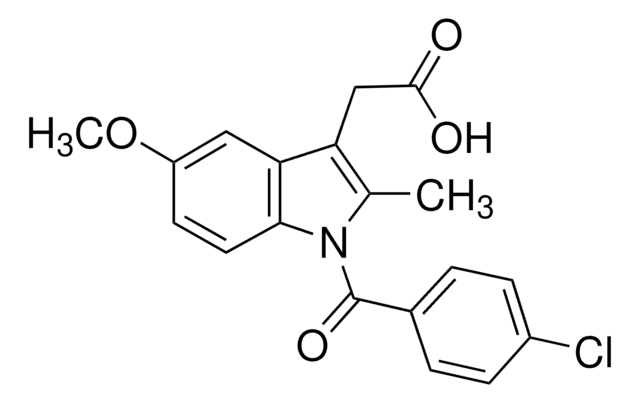405268
Indomethacin
≥98% (HPLC), powder, COX inhibitor, Calbiochem
Synonim(y):
Indomethacin, 1-( p-Chlorobenzoyl)-5-methoxy-2-methyl-1H-indole-3-acetic Acid, 1-(p-Chlorobenzoyl)-5-methoxy-2-methyl-1H-indole-3-acetic Acid
About This Item
Polecane produkty
product name
Indomethacin, A non-steroidal anti-inflammatory, cell permeable, antipyretic agent.
Poziom jakości
Próba
≥98% (by assay)
Postać
powder
siła działania
740 nM IC50
producent / nazwa handlowa
Calbiochem®
warunki przechowywania
OK to freeze
kolor
white to off-white
rozpuszczalność
ethanol: 20 mg/mL
Warunki transportu
ambient
temp. przechowywania
10-30°C
InChI
1S/C19H16ClNO4/c1-11-15(10-18(22)23)16-9-14(25-2)7-8-17(16)21(11)19(24)12-3-5-13(20)6-4-12/h3-9H,10H2,1-2H3,(H,22,23)
Klucz InChI
CGIGDMFJXJATDK-UHFFFAOYSA-N
Opis ogólny
Działania biochem./fizjol.
Ostrzeżenie
Inne uwagi
Weggen, S., et al. 2001. Nature414, 212.
Kalgutkar, A.S., et al. 2000. Proc. Natl. Acad. Sci. USA97, 925.
Klabunde, T., et al. 2000. Nat. Struct. Biol.7, 312.
Futaki, N., et al. 1994. Prostaglandins47, 55.
Futaki, N., et al. 1994. Prostaglandins47, 55.
Stevenson, K.M., and Lumbers, E.R. 1992. J. Dev. Physiol. 17, 257.
Oliw, E. 1980. Prostaglandins19, 271.
Informacje prawne
Hasło ostrzegawcze
Danger
Zwroty wskazujące rodzaj zagrożenia
Zwroty wskazujące środki ostrożności
Klasyfikacja zagrożeń
Acute Tox. 1 Oral
Kod klasy składowania
6.1A - Combustible acute toxic Cat. 1 and 2 / very toxic hazardous materials
Klasa zagrożenia wodnego (WGK)
WGK 3
Temperatura zapłonu (°F)
Not applicable
Temperatura zapłonu (°C)
Not applicable
Certyfikaty analizy (CoA)
Poszukaj Certyfikaty analizy (CoA), wpisując numer partii/serii produktów. Numery serii i partii można znaleźć na etykiecie produktu po słowach „seria” lub „partia”.
Masz już ten produkt?
Dokumenty związane z niedawno zakupionymi produktami zostały zamieszczone w Bibliotece dokumentów.
Klienci oglądali również te produkty
Nasz zespół naukowców ma doświadczenie we wszystkich obszarach badań, w tym w naukach przyrodniczych, materiałoznawstwie, syntezie chemicznej, chromatografii, analityce i wielu innych dziedzinach.
Skontaktuj się z zespołem ds. pomocy technicznej







